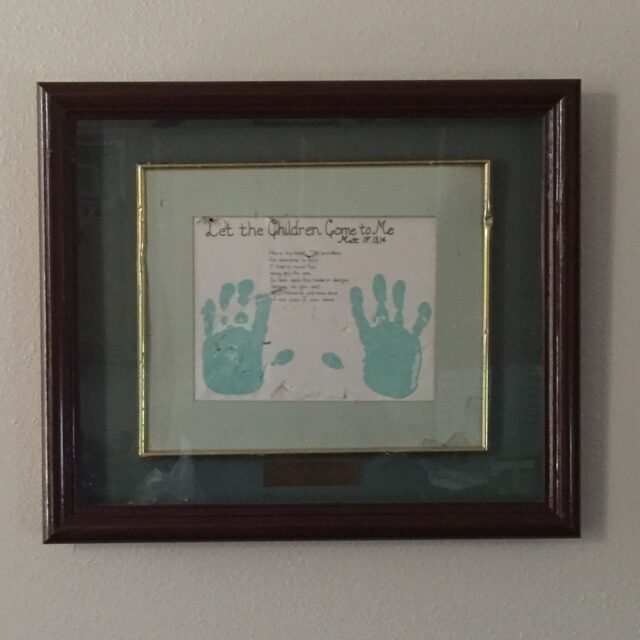DC3 Administrator Shares Memories of OKC Bombing 25 Years Later
Published April 20, 2020
At the time of the Oklahoma City bombing in 1995, Dr. Glendon Forgey (who is now the DC3 vice president for administration and finance) worked for the Oklahoma State Regents for Higher Education. Forgey’s office, which was located on the second floor of the Journal Record Building, had a window that directly faced the Alfred P. Murrah Federal Building.
By Glendon Forgey – written in April 1995
“It all began with that shoe on the wall. A shoe on the wall….? Shouldn’t be there at all!”
This quote from Wacky Wednesday, by Dr. Suess is my way (hopefully) of bringing a little bit of levity to the horrendous event on April 19th in downtown Oklahoma City. Maybe this is just my therapeutic way of psychological healing. It is not my intention to offend anyone.
I want to thank everyone who sent cards and flowers. I think you made a mountain out of a molehill, but I appreciate your concern. I have heard all over Wellston (my community) stories of what happened to me during the explosion and subsequent events. The embellishments remind me of the quote from Mark Twain, “The reports of my death are greatly exaggerated.”
I am very thankful to God to be alive today and to have suffered what I consider to be minor injuries. I will heal; many of my colleagues will not.
I work for the Oklahoma State Regents for Higher Education. My office is located on the 2nd floor in the Journal Record Building. Jessica Danker, another Wellston native, works for the Journal Record. I thought about her when I was lying in the hospital waiting to get stiches. I always thought having an office with a window was a perk. I’m beginning to wonder now. I think I’ll request a steel vault in our new location.
The window in my office faces the Murrah Federal Building. I estimate that it is approximately 125’ from the origination of the bomb to my office window. The only thing separating my office from the bomb is a parking lot, which unfortunately did nothing to buffer the impact of the explosion.
At 9:02 a.m. I was in my office speaking with a colleague, Rick Edington. My desk faces the window, but I was standing with my back to the window (talking to Rick) who was facing me and the window.
When the bomb exploded, I did not know what happened. I thought lightning had hit our building. The force of the impact threw me through the wall of my office, or rather where there used to be a wall, into the visitor waiting area. I immediately went back into my office to look for Rick.
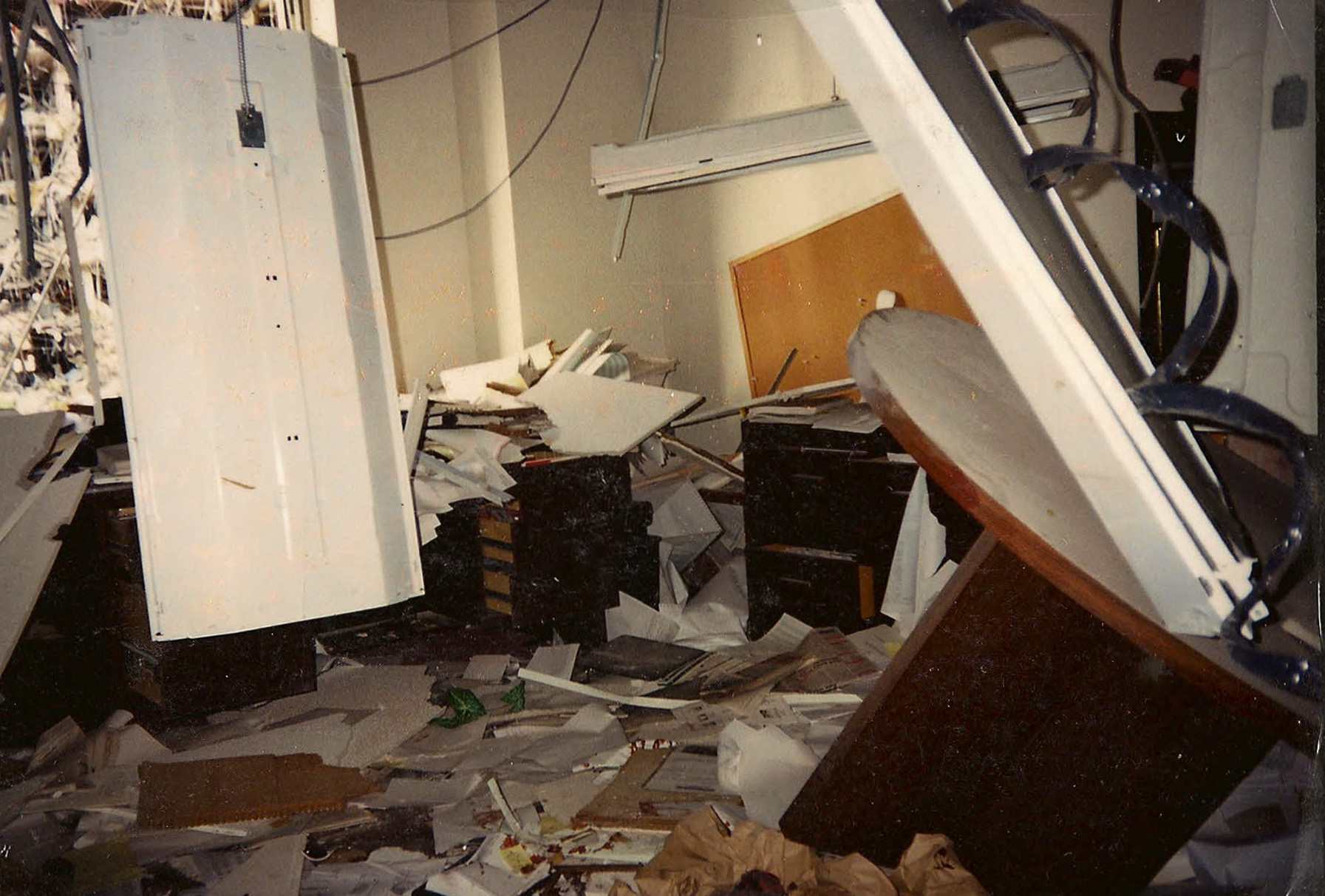
Conduit cable, wire, ceiling tiles, and other debris were hanging from the ceiling. I was concerned about being electrocuted by the dangling wires, but I didn’t see any wires exposed so I went further into my office to find Rick. I couldn’t see Rick and there was a lot of dust in the air and that coupled with the loss of my glasses just exacerbated the situation. I called for Rick and didn’t hear any response. There was still a ringing in my ears from the explosion. I finally heard Rick’s voice calling for help. “Glendon, I’m on the floor. The table is on me,” he groaned.
The force of the explosion blew the glass windows into my office. I did not realize it at the time, but I had deep lacerations in on various parts of my back, right shoulder, a few cuts on my face and above my right eye. It was then that I realized that the cuts on my back and shoulder were so severe that I could not move my right arm. Adrenaline took over. God gave me the strength to lift and toss the conference table off Rick with my left hand. I still remember picking the table up and throwing it across the room to find Rick. This is a table that usually requires two people to move.
After moving the table, I saw Rick lying in the floor. His face was a crimson, bloody mess. He continued to moan for help. Just then our security officer came in to my office. I informed him about Rick’s condition and that we needed an ambulance. I really didn’t want to leave Rick, but the security officer told another staff member to help me out of the building. I didn’t leave though. I proceeded to look for other staff members under my supervision. I called for them and looked into what was left of their offices. I didn’t see or hear anyone and was advised that everyone who was mobile had already left the building. The security officer came up to me again and said that I really needed to leave as there might be a gas leak.
Rick had been loaded to a stretcher and I felt that I could now exit the building. Through all the excitement and confusion, I hadn’t really noticed that my back and shirt were damp, but now I realized it. I knew it was probably blood, but I still did not know how bad the lacerations were. I stopped into the women’s restroom to wash off my hands. I had to use the women’s restroom because the men’s restroom had become inaccessible. As I think back, I was not very smart for not making a more expeditious evacuation from the building. I am sure, or at least like to tell myself, that I was just being concerned for the well-being of my colleagues. I wanted to make sure Rick had been helped.
Before I left the building, I went back to my office and retrieved my briefcase and car keys. Although I was still unaware of the extent of my injuries I thought I would probably need to get a few stitches. I left my suit coat and tie, both were stained with blood anyway, but I thought I could get them later. However, my pants were bloodstained and torn, so the suit coat wouldn’t have really mattered.
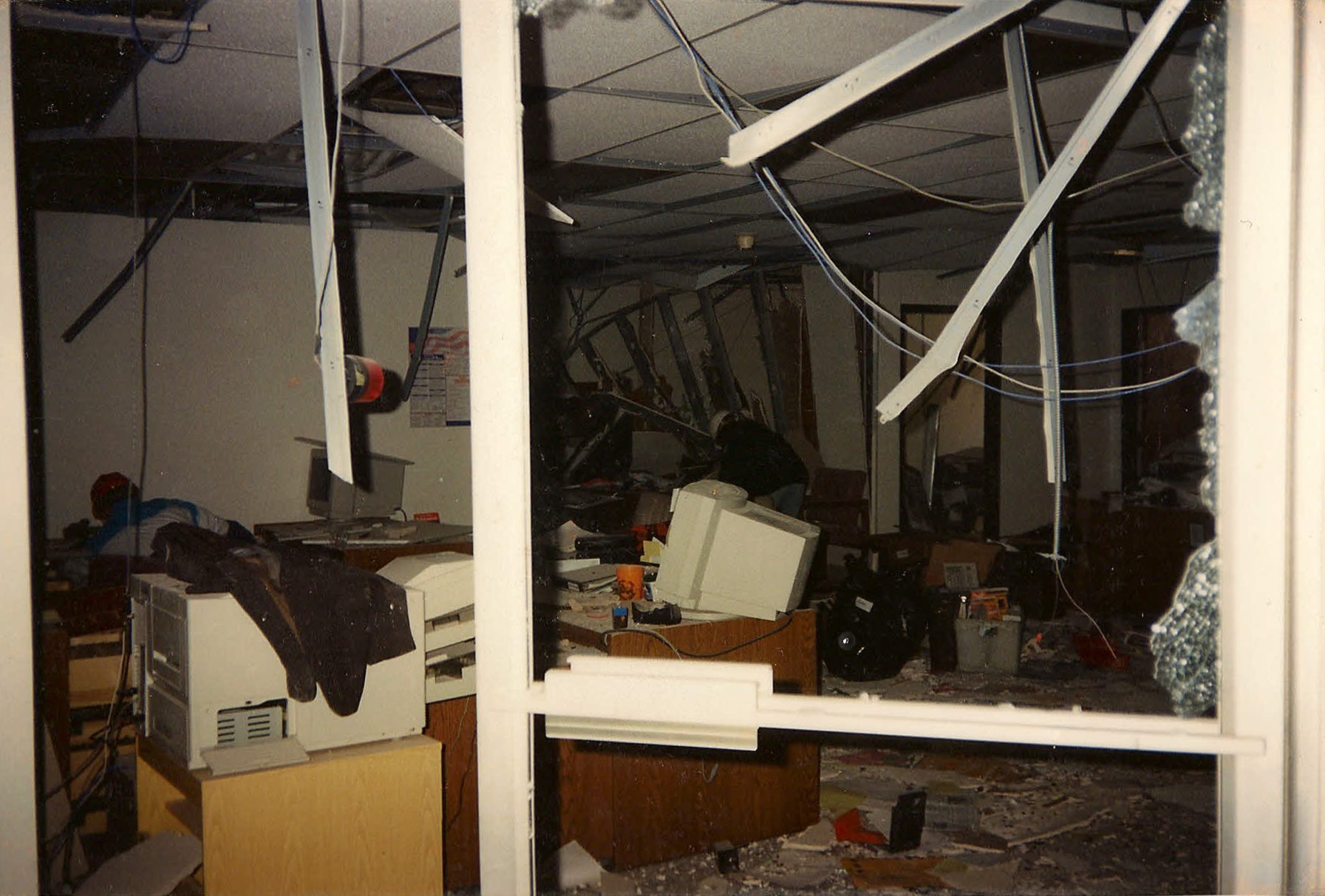
I don’t remember going down the stairs to exit the building as I was started to get light headed due to the loss of blood. A colleague helped steady me and helped me out. When I reached the entrance to the Journal Record Building (the ground floor) I observed that glass was everywhere. I began spitting on the ground to get the dust and other debris out of my mouth that I had inhaled while in the building. Then someone came up and told me to go across the street and sit down.
The north breeze and my blood-soaked shirt combined to make a very chilly effect, so I took off my shirt, wadded it up and pressed it against the gashes on my back. A colleague later told me that CNN had shown me taking off my shirt as I left the building. It was still cold without my shirt, but I thought I would be warmer without wearing it and I could use it on my wounds.
At approximately 9:15 a.m. I was instructed to go to the northwest corner of 6th and Robinson and sit on the curb. The rescue workers said that the people sitting on the curb would be taken to the hospital in ambulances. I didn’t feel like sitting. Besides, my arm and shoulder were hurting too much and I couldn’t let myself down on the curb to sit. There was no one there to help me sit down, so I just leaned against the hood of a parked car. In addition, I wasn’t sure I needed to go to the hospital, just to a doctor.
Several of our staff had mobile phones, so I asked one of them to call my wife, Judy. Judy said she got a call that I was okay, and that they were only taking the seriously injured people to the hospital. She subsequently received another call that I was being taken to the hospital. Judy became a little more concerned.
I continued to walk around requesting updates on the status of colleagues. I also asked about my briefcase as it was carried down by another colleague on my way out of the building. My wallet was in my briefcase and I thought I would need it to drive home. I guess I still thought I wasn’t seriously injured to where I needed to be taken to the hospital.
Rick Edington’s secretary, Suzanne Onofrey, finally convinced me to sit down because I was “looking pale.” I told her that without my shirt I always look pale. In high school one of my nicknames was “white lightning” because of my light complexion and speed. With auburn colored hair, I don’t tan, I just burn. Suzanne laughed and said that I was still bleeding pretty badly from my back.
Suzanne helped me sit down on the curb and I waited there a few minutes until a rescue worker came over and wrapped a temporary bandage all the way around my back and chest. They taped the bandage on pretty tight and I grimaced when the moved my right arm due to the deep cut on the back of my shoulder. The rescue worker told me to remain sitting and that an ambulance would be available shortly to take me to the hospital.
While I had been walking around and moving I hadn’t noticed the cold so much, but now sitting stationary on the curb, I began to get cold again. Suzanne noticed me shivering and brought a blanket for me. I still felt there were people hurt worse that I was and my knees and hips were beginning to ache from sitting on the curb. I was also looking into a bright sunlight which was hurting my eyes. With some assistance, I rose to my feet and walked to the other side of the street to sit on the hood of a car.
After about 5 minutes of sitting on the car hood, I began getting dizzy and paler (if that is possible). Penny Gandy, one of my staff members, led me back across the street to sit down. A few minutes later, the emergency technicians were loading me onto a stretcher and into an ambulance.
There were two of us in the ambulance; another man and I. I heard the other man requesting to go to Veterans’ Hospital, but the EMTs were going to Presbyterian Hospital. I was glad we were going to Presbyterian as I was a little more familiar with the Presbyterian Hospital. My son, Seth, has had to go there a few times when his asthma gave him problems.
The EMTs taped me to the stretcher with tape going across my legs, waste, and head. They put a neck brace on me even after I told them that my head and neck were okay. I told them that my back and shoulder were really hurting. Well, that made no difference to them and they placed a neck brace on me anyway. The neck brace was a little tight making it difficult to breathe. I thought, “These guys are going to kill me before I get to the hospital.” One of the EMTs loosened the neck brace a little, but told me to keep my head still. The ride to the hospital was very uncomfortable, due mainly to be being laid on my back and shoulder where the most severe wounds were located.
My watch beeped about the time the ambulance arrived at the hospital, so I knew it was 10:00 a.m. The nurses or workers got me out of the ambulance and proceeded to hit every bump and run my stretcher into every door available. “Oh, well, “ I thought, “It’s a little hectic and they are just doing their best.” It still didn’t help my back and shoulder though.
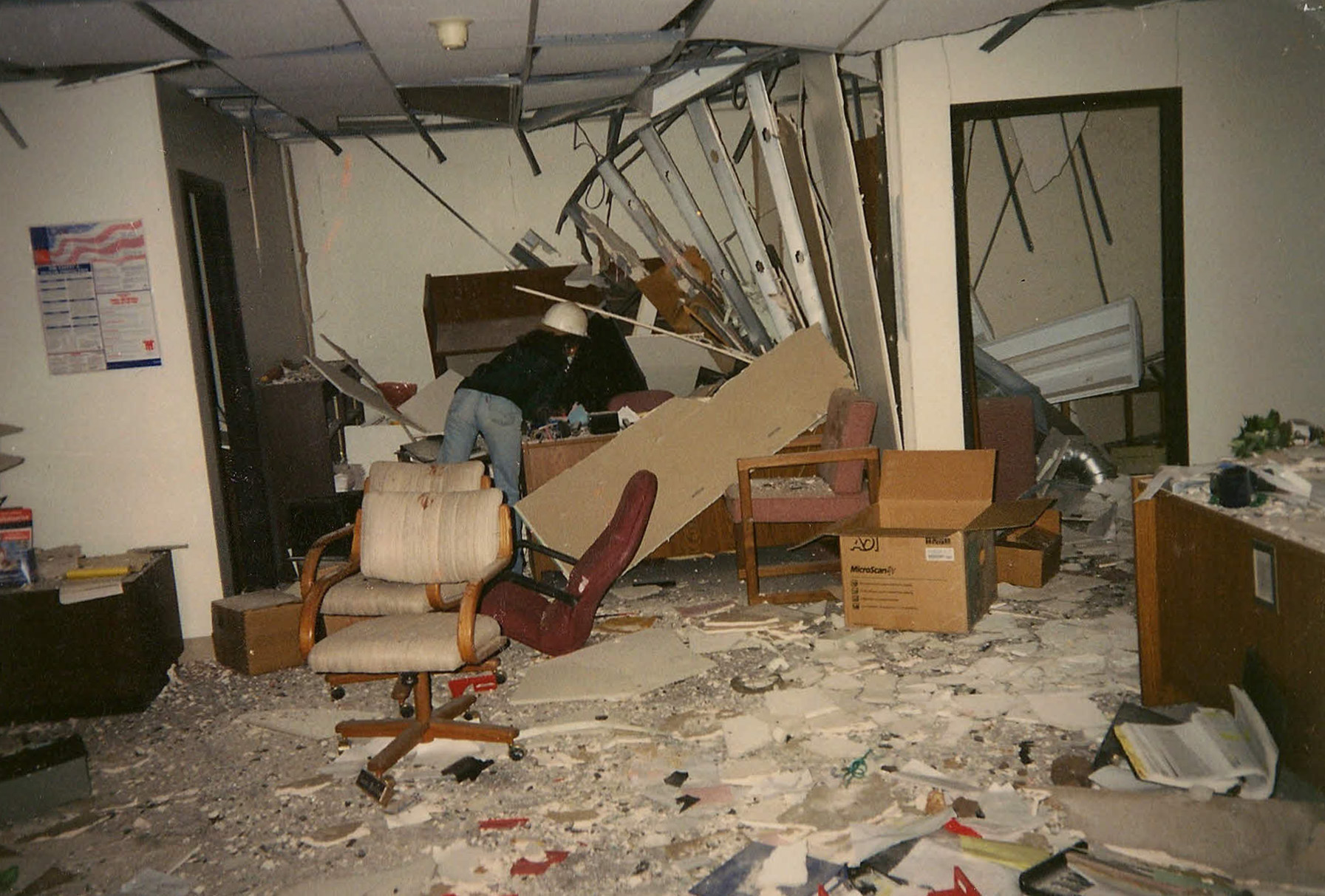
A nurse asked me my name, age, address, etc. She asked me if I had lost consciousness. I told them that I hadn’t, just the little cuts around my eye. I didn’t realize at that time that I also had some lacerations behind my ear and in my scalp.
The nurse put the information on a tag, put it on my wrist, and I was on my way. I was wheeled on the stretcher into an elevator. I think we went up two floors. The hospital had blast victims in hallways and in all other available rooms. I could hear bits and pieces of television news as they pushed me down the hallway, but I couldn’t hear enough to know what was happening.
The nurse continued to push me to the end of one hallway where I was out of the way. The first thing they did was x-ray my neck, head, and shoulders. I remember the excruciating pain that I felt as they lifted my shoulder to place the film plate underneath it.
It took about 5 minutes for the film to develop, and after they were convinced I had no serious neck or head injuries, they removed the neck brace and tape that had been put over my head to keep it immobile. The EMT had put the tape over my hair and eyebrows. When the nurses removed the tape, I was concerned whether my hairline would be receding even further and if I would have any eyebrows left. But, the nurse was careful and I didn’t lose too much hair or my eyebrows.
My head was now free and I could hear things a little better. The tape had muffled a lot of the sound. There was a television on in the background of where I was lying; however, I was mostly hearing doctors and nurses talking. Most of the conversation was about the bomb victims and what procedures to perform. I suppose they did not consider my wounds as critical because they were treating other patients first.
The hospital hallway seemed as cold as when I was outside of the Journal Record Building sitting on the curb. A nurse covered me with a blanket. I was still shivering, so she put two more blankets on me. I was still taped to the stretcher and I was in considerable pain from my shoulder and back injuries. I asked the nurse if I could sit up. She asked a doctor and he said it was okay. The nurse removed the tape that was across my waist and legs and I sat up on the table.
I hadn’t been sitting up very long when they came to get me to treat my wounds. The nurse asked if I could walk to the room. I told her I thought I could. I was a little wobbly, but the nurses helped me into the MRI room. As I mentioned, the hospital was using every available room. The mammography room was just next door.
I sat up on the table and the nurse began removing the temporary bandage that was put on by the EMTs. The EMTs had wrapped tape around my chest and back several times to keep the gauze pads in place. The tape and gauze were wrapped tightly to put pressure on the most severe cuts. I watched the nurse remove the tape and joked with her, “This is one of those times I am glad I don’t have a lot of hair on my chest.” I knew, from having my ankles taped in high school that pulling the tape off the hairy parts of one’s body is not an enjoyable experience.
Once the tape and temporary bandages were removed, the nurse, Laura, and doctor (Dr. Carson) had me lay on my stomach. Dr. Carson told me I had some pretty bad gashes across my back. He told me it appeared as if someone loaded a shotgun with glass and shot me in the back. Dr. Carson asked for suture kits, but was told they were out. The hospital had used up their supply. I remember someone saying that taxis were having to bring supplies to the hospital because all of the ambulances were being used.
A nurse asked me if she could call anyone for me. I gave her my home phone number and my parents’ phone number. The nurse left and made the calls while the doctor began applying the anesthetic to the areas he would be treating. The nurse said she called my home and got the answering machine, so I gave her my inlaws phone number. Dr. Carson had begun stitching me up. I had been bleeding so much that the table was now being soaked with blood, especially around my neck and head. Dr. Carson asked the nurse to put a towel under my neck to soak up some of the blood.
The nurse came back in and told me she called my wife, Judy, who was at her parents’ home. She told me that Judy was on her way to the hospital. Dr. Carson continued working on the worst cut. He did not find any glass in the wounds. Another doctor, Dr. Pressey, came in to assist Dr. Carson. Dr. Pressey worked on one side of my back while Dr. Carson continued on the other side.
I was still bleeding, pretty badly I guess. I could feel the blood running down my shoulder and down the middle of my back. The blood was also continuing to run down my neck and onto the towel that the nurse had put underneath me. I heard Dr. Carson tell Dr. Pressey that an artery was nicked. I suppose that was why there was so much blood.
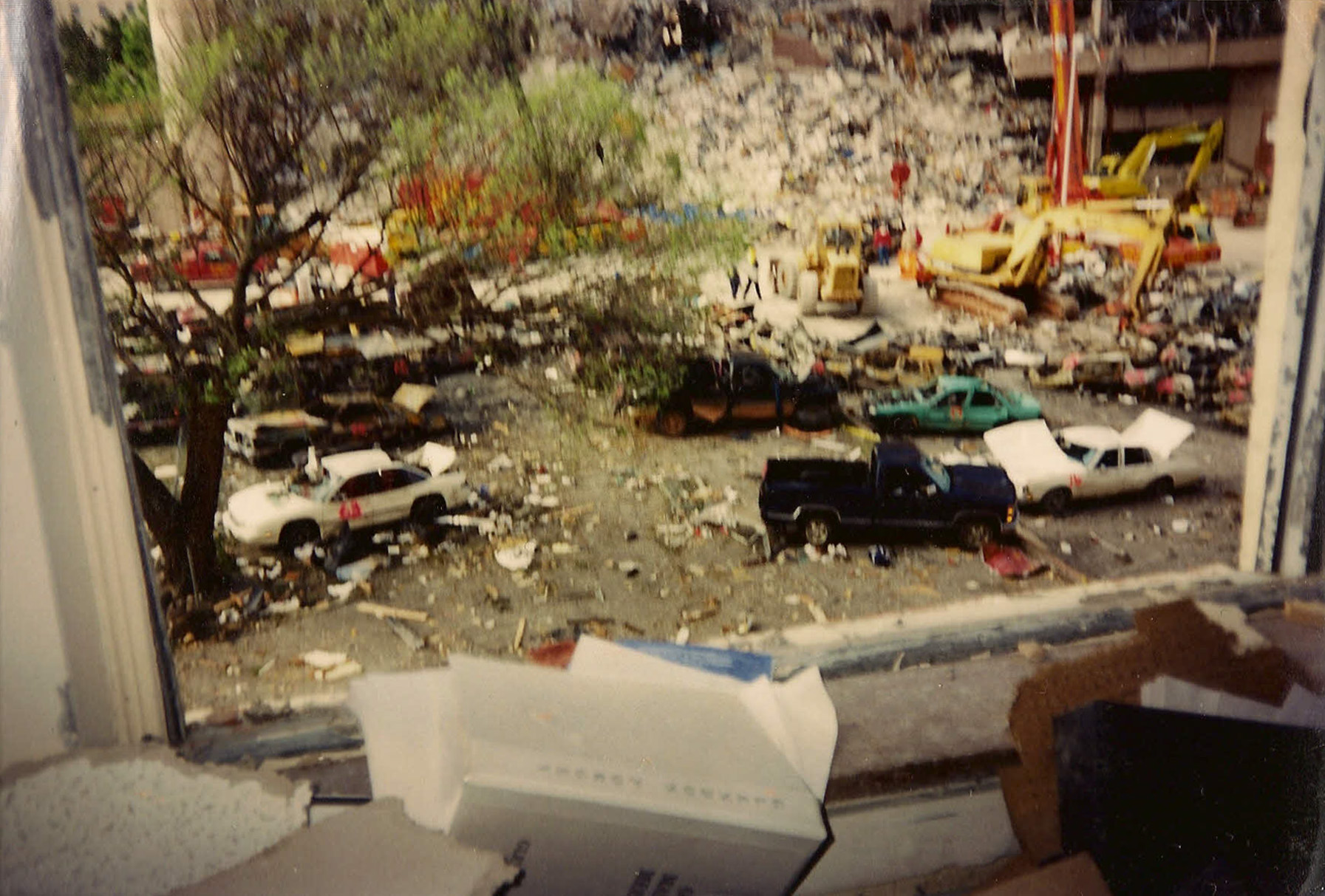
I don’t know how long Dr. Carson worked on the one gash, but I wondered if he were ever going to get it to stop bleeding. He told Dr. Pressey that “he had a bleeder”. That didn’t sound like good news to me. Dr. Carson made the statement that I was pretty lucky. I quickly corrected him and told him that God was watching out for me. He and Dr. Pressey concurred.
Judy entered the room about this time and we began to talk. I think she was relieved to see that I was conscious and alert. However, I think she was a little disturbed by the sight of my back. Judy and I discussed what happened. She was providing me with updates on the status of Rick and other colleagues who were injured. I thought I heard my boss out in the corridor. Judy quickly volunteered to go out and check because the sight of my back was making her nauseous.
Doctors Carson and Pressey continued their work. They hadn’t known each other before the explosion. Dr. Carson was from Utah; Dr. Pressey from Texas. Dr. Pressey explained that medicine was his third career. He had been an oil field worker, then received an engineering degree from Texas A&M, then returned to medical school. I thought to myself, “Third time is a charm.” Dr. Pressey was an intern who had been working in the ER. Dr. Carson was an arthritic physician, but all physicians, no matter their specialty were called in to the hospital to treat the wounded that day.
The nurse came in about 11:45 and asked “Do you guys want a sandwich and something to drink?” I knew she was directing her question to the doctors, but I replied, “Yeah, that sounds great. I haven’t eaten anything today and it’s past my lunchtime.” The sandwiches and sodas came a little later, but there were only two. “Oh, well,” I thought to myself, “I couldn’t eat them in my position anyway.”
The blood was still running down my neck from the most severe cut. Dr. Carson asked nurse to place another clean towel to put under my neck and shoulder. The first towel was pretty much saturated with blood. Although I didn’t complain, I think Dr. Carson could tell I wasn’t thrilled with lying in all the blood. I looked at the first towel once and Dr. Carson told me not to look anymore. He really didn’t have to tell me, I really didn’t want to see it. I get squeamish very easy.
The doctors finished working on my back around 12:30. They began cleaning my back off and kept finding more lacerations. These weren’t as deep of cuts as the ones the doctors had been treating, so the doctors used butterfly stitches to close the minor wounds. I remember from my office blood dripping from my chin. I assumed it was from the cuts above and around my eye, but the doctors found a cut behind my right ear too and used another butterfly stitch to treat it.
After the doctors finished treating my back, they began working on my face, hands, wrists, and arms. As the doctors continued their work, the nurse noticed blood on my lower back near my waist. She asked that I loosen my pants. She looked and determined that the blood had accumulated there from the cuts to my back. I advised her that I thought a lot of the blood had run down my back and into my pants.
Dr. Carson said there was no glass in any of the major wounds, just very deep lacerations. He mentioned that my shoulder muscle may have been mashed a little, but that it should be okay in a week or so. Dr. Carson also told me that there might be small fragments of glass in some of the smaller cuts, but they would work out. (Actually, I still have one fragment that never has.) He asked if I had received a tetanus shot lately. I told him it had probably been 20 years. He recommended that I get a shot. I went over to the Midwest City branch of the Oklahoma City Clinic and got the shot later that afternoon. For some reason they couldn’t give me the shot at the hospital.
It was approximately 1:30 p.m. when they finally finished and said I could leave. I had only been at the hospital for 3 hours. Judy’s mother purchased a T-shirt for me from the hospital gift shop to wear on the way home since my other shirt was no longer fit to be worn. On my way out of the hospital I checked on the status of my colleagues one last time. Rick was reported as having a broken wrist, facial lacerations, possibly losing an eye. I spoke with Rick later and found out he didn’t break his wrist or lose an eye, but did have bad cuts around his eyes. Rick was being kept overnight for observation as the doctors were concerned that his liver may have been damaged when the table in my office fell on him. Rick’s wife was scheduled to have their second child the next day. I really felt sorry for him. Fortunately, his liver was only bruised and he was able to go home the next day. Other colleagues were not as fortunate. One colleague received massive lacerations to her face and had over 1,000 stitches. Some lost their lives.
This is why after hearing about my other colleagues and the 168 people in the Murrah Federal Building who lost their lives, that I consider my injuries insignificant. I didn’t understand all the attention I was receiving, but I appreciated the concern.
As I walked out of the hospital a couple of acquaintances patted me on the back, not knowing that was where my most severe injuries were. I think they knew after I grimaced that they had done something wrong, but they were only trying to show their concern and support.
We drove over to Judy’s parents’ home and I rested for a while. I finally got to eat around 2:30. Judy went to Subway and bought me a sandwich, which is what I wanted to eat. While there, I called my father and told him I was okay. My mother suggested I stay in town a few hours and make sure I had no complications, but I was anxious to get home, see our children, and get out of my bloody clothes. I could still feel that squishy feeling of blood in my underwear.
My children, Seth and Jenna (ages 10 and 7), didn’t know I had been injured. When I came home that afternoon they saw my wrist and other injuries and asked what happened. I told them I had a bad day at the office. Then I told them what happened but that I was okay. Judy changed the bandage the next day and Seth and Jenna wanted to see my back. Seth said I looked like Frankenstein.
The next day, Thursday, I was determined to obtain a new pair of glasses so I could see a little better. I had been using an old pair, but the prescription wasn’t as strong as I needed. I stopped by our local high school to sign some letters (I was president of the school board and the school needed my signature). The superintendent advised me that LensCrafters was providing free glasses to the bomb victims. Sure enough, Judy drove me to LensCrafters and I received a free pair of glasses.
I had been concerned about my car which I had left in the Journal Record Parking Garage. I called the garage Thursday night and a gentleman answered, “Logistic Control Center.” I explained that my car was there and asked if I could get it out. I described my car and where it was located. I waited while they checked on it. After a couple of minutes the man said, “Your car is fine. No damage. There is a mobile Taco Bell unit behind it, but you can come get it.” I told him I would come in the morning (Friday). He told me to go to the command post at 8th and Harvey as the FBI and other agencies were being very restrictive on whom they were letting in to the bomb area.
Friday morning, Lane Buckley, a friend of mine, drove Judy and I into Oklahoma City. A policeman stopped us at 8th and Hudson and wasn’t going to let us through. After I talked to him a few minutes and told him I was instructed to go to the command post and get a pass. The policeman looked at my bandages and sling (my arm was in a sling from the wound to my shoulder) and decided to let us through.
We arrived at the command post and there was a long line of people waiting to receive a pass to obtain access to the bomb area. The line seemed a mile long. The Journal Record Garage manager and one of my colleagues were at the front of the line. They spoke to one of the policemen and they moved me to the front of the line because of my injuries.
Judy and I received a pass to go to the garage after showing identification. We walked to the garage and found my car completely surrounded. It looked like it was going to be impossible to get it out of the garage. The Taco Bell mobile unit was parked directly behind my car and the Red Cross had set up tables and chairs on both sides of my car to feed the rescue workers. I didn’t think we were going to get my car out. However, the Taco Bell employees moved the tables and chairs and pushed the Red Cross van to the very back of the garage wall. Judy was able to back our car out of the garage diagonally across three parking spaces a foot at a time.
I was allowed to go back into the building on Friday, two days after the bombing, and retrieve my personal belongings from my office. Most of my books, stereo, pictures, and other personal items were salvageable. Some things weren’t. My favorite picture of my son’s handprints was damaged. I had the pictured encased and now have it hanging in my office. Most of these material items can be replaced; however, the lives lost as a result of the bombing will be gone forever. Their lives will be remembered by their loved ones, friends, and colleagues, as will my memories of that day.
